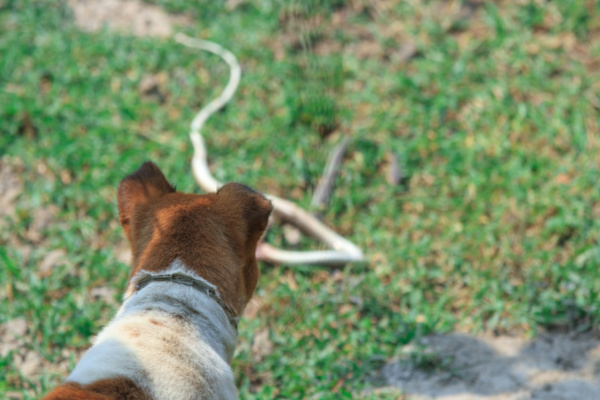 Rattlesnake Vaccine for Pets loses USDA License just as Snake Season Ramps Up
Rattlesnake Vaccine for Pets loses USDA License just as Snake Season Ramps Up
Just as the weather warms, the rattlesnake vaccine that has been in use for more than 20 years for dogs, cats and horses has lost its U.S. Department of Agriculture-issued license.
History of the Rattlesnake Vaccine
Dr. Dale Wallis DVM and her partner Jim Wallis, developed the Crotalus Atrox Toxoid vaccine in the early 2000s. The event that prompted Wallis’ efforts to produce a vaccine was the death of her cat after it was bitten by a western diamondback rattlesnake. “In 2002, my cat was bitten by a rattlesnake and nearly died,” Wallis said. “Shortly thereafter, my partner, Jim Wallis’ cat, was bitten by a rattlesnake and nearly died. Both cats lived, but both were very severely affected, and we thought, ‘Gee, there ought to be something we can do about this.’”
By 2003, she said they had created a rattlesnake vaccine for dogs and horses. It was licensed both in the state and by the USDA in 2004. Originally, it was for dogs and some horses, only. Later, it was determined to be effective for cats. In many parts of the country rattlesnake bites kill thousands of dogs and cats each year as well as a smaller number of horses. The need was there and so was a market.
“The product we came up with does generate anti-venom, kind of antibodies, in the vaccinated animal. So, you already have antivenom on board if you get bit,” she said. “What that means is that you’re much better protected.” Wallis said their company, Red Rock Biologics, was distributing hundreds of thousands of vaccine doses every year for the last two decades–serving about 5,000 clinics across the country. “This came to an abrupt halt in 2023 when they pulled the license. They refused to renew it,” Wallis said.
Wallis said the USDA’s decision had to do with a time limit on their conditional license, but when they submitted more data for a full license, she said the USDA didn’t accept it. They are trying hard to get the license back, and are hoping to be successful – eventually. But counting on anything necessary being done quickly within the current chaotic state of U.S. regulatory agencies is unlikely.
Some Doubt its Efficacy
Some experts have argued that the vaccine doesn’t have any published data to support its efficacy. That was written in the Canine Vaccination Guidelines, published by the American Animal Hospital Association in 2022. However, the AAHA still includes the rattlesnake vaccine in their list of noncore vaccines for dogs. Those are vaccines recommended for some dogs based on lifestyle, geographic location, and risk of exposure.
How the Vaccine Works
As Charlie Powell, a retired PIO for Washington State University’s College of Veterinary Medicine reported for the Moscow-Pullman Daily News in Idaho, a little science is necessary here to better understand how a vaccination can protect an animal from a rattlesnake bite. Rattlesnake venom is a complex mixture of toxins, generally made of proteins.
When foreign proteins enter an animal, they trigger an immune response and antibodies are made. Antibodies are also proteins. Triggering the immune system to build antibodies that will attack and destroy a specific foreign protein when it is encountered again is the fundamental basis for building many vaccines.
How Venom Spreads
Venom can spread very rapidly depending on where the bite occurs. If it happens to get in the arterial bloodstream, that’s bad. If it gets in tissues with less blood flow, the effectiveness of the toxin can be slowed down and the effects reduced. Know, too, that it is estimated that 50% of all rattlesnake bites are dry bites, meaning no venom is injected.
People are curious as to why a snake would issue a dry bite. Consider that for a rattlesnake to produce venom, it takes a good amount of metabolic energy. That means the snake must eat well and to do so, it must use its venom. Venom is both precious and energetically costly in a rattlesnake’s quest for survival and reproduction.
Next, imagine a snake is perhaps stalking prey. Along comes a creature far bigger than it could ever consume — such as a dog, adult cat or horse — that may interrupt the hunt. The snake can be thought of as getting angry and so it tries to scare the bejesus out of you with a strike. You have a 1 in 2 chance the bite will be dry, as the snake may conserve the costly fluid.
If a dog, cat or horse steps on the rattler, its life is in danger and it may issue an envenomated bite, even if mortally wounded. With multiple dogs afield, it is typically not the first dog that gets the venom. It is the second dog that saw the first dog jump and yelp that runs over to see what all the fun is about that gets hit with envenomated bite.
Venom volume and toxicity varies among the subspecies of rattlers. Eastern diamondbacks often have a head the size of a tennis ball and are dangerous by volume. The Mojave rattlesnake produces the most potent venom containing Mojave A, a component that is profoundly neurotoxic. “
Ongoing Efforts to Get the License Renewed
This is a safe and effective vaccine. It is well-loved, well-liked, well-supported. It’s needed,” Wallis said. As KTVZ 21 reports, Wallis states that they made enough vaccines to carry them until June, but they are about to run out, and are still fighting for a license to make more.
Just last week, she sent a letter explaining the situation to clinics across the country that use their vaccine. She said she has received letters of support from more than 50 veterinarians and is hopeful they will get their license back. “It satisfied all the regulatory requirements for the licensing it has. There’s no reason for it to have lost its license,” she said. “It’s a fundamental misunderstanding of what the vaccine is, how it works. It’s the only one in the world.”
Wallis said they are planning to meet with the USDA to address the issue. In the meantime, she recommends rattlesnake avoidance training to protect your animals.
—
Photo Credit: Lemon Studio / Shutterstock.com


